Many people swear by the benefits of bone broth. Here’s how to make this rich, flavorful stock, plus several tips for cooking with it.
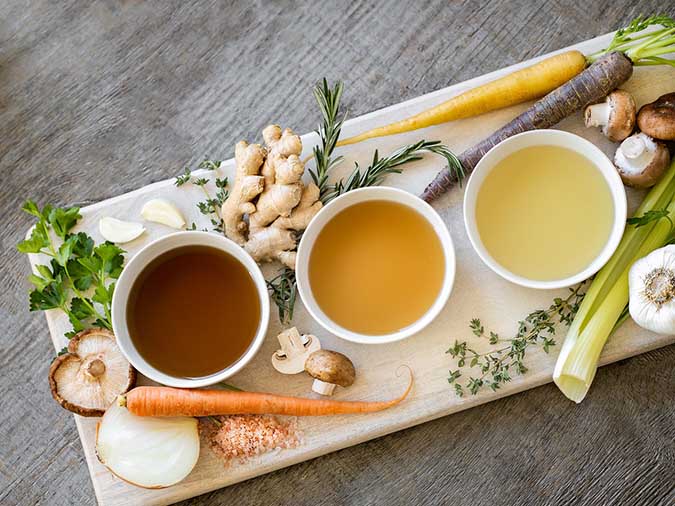
Image by Bluebird Provisions from Pixabay
How to Make Bone Broth in 5 Easy Steps + Benefits & Uses
Bone broth is a bit trendy right now and lots of people are making grand claims about the miracle benefits of using it. And so, of course, it is also attracting lots of naysayers rightly pointing out the fact that there is very little scientific evidence to support these claims. The truth is that scientists haven’t really taken a close look at bone broth yet, and so there’s just not much out there by way of reliable data.
The Facts: Benefits of Bone Broth
Here’s what we do know about bone broth:
- Recent research suggests that bone broth has some minerals, but it probably isn’t a mineral miracle1)https://www.ncbi.nlm.nih.gov/pmc/articles/PMC5533136/. Eating lots of leafy greens is a better way to up your mineral intake.
- Bone broth most certainly contains lots of protein and amino acids that our bodies need2)https://www.alive.com/health/bone-broth-analysis-reader-research/ 3)http://time.com/4159156/bone-broth-health-benefits/ and as such is a great way to get more protein and calories out of the animals we already raise for meat.
- Long-boiled bone broth can be an awesome source of gelatin, and there is a good amount of evidence to suggest that gelatin has positive benefits on joint, liver, intestinal, and even mental health.4)https://www.healthline.com/nutrition/gelatin-benefits#section4
Most of the “debunking bone broth” articles tend to revolve around speculation from those who have backgrounds that qualify them to have an opinion. But lack of scientific evidence aside, as the operator of a human body and an almost daily eater of bone broth, I also feel qualified to speculate on this subject.
You May Also Enjoy:
“Get TGN’s Immunity Support Kit at an Incredible Discount”
And here’s what I think:
Bone broth is good for me—not as a fad or gimmick or miracle cure—but as part of a balanced, whole foods diet. I know this in the same way that I know when I have a cold or a stomach ache. My body tells me so. And for me, that evidence is irrefutable and is the main reason why I use bone broth almost every day.
What Is Bone Broth?
Let me clarify what I mean by “bone broth” or “bone stock.”
I am not referring to that pathetic watery substance you get at the grocery store. As far as I am concerned, that is poorly flavored water compared to the richness and density of the real deal.
Bone broth, once cool, has a consistency similar to canned cranberry sauce (though much tastier) and color ranging from buttery yellow to dark, golden brown.
You can cut it with a knife and make a clean break.
When you put a spoon of it in a hot pan, it melts like butter. My definition might be narrower than others, but that’s what I eat and that’s the stuff I can vouch for being beneficial to my body.
Choosing Your Bones
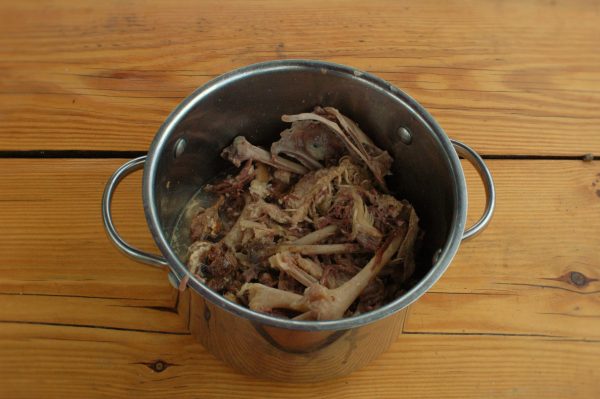
To make bone broth like that, you don’t just use clean bones. You want all the grisly and fatty bits that you normally push to the side of your plate. Joints, cartilage, skin, and pretty much anything you can’t normally chew should be used.
If you process your own animals, you can also throw in heads, feet, and organs that you might not like the texture of (hearts, gizzards, kidneys).
You can use about any variety of animal bones—rabbit, chicken, duck, turkey, pig, beef, deer, fish, etc.
You May Also Enjoy:
“The 5 Best Garlic Supplements”
You can start with raw or cooked bones. Roasted bones make stock a bit more delicious. And raw bones will make more “scum” at the top of the pot when it first starts to boil. Some people skim this off. Me? I just let it cook until it blends back in.
Due to the amount of time (and probably energy) involved in making stock, saving your bones until you have enough to make a large batch of stock is a good idea. Store your leftover dinner bones and bits in the freezer until you are ready to use them.
How to Make Bone Broth
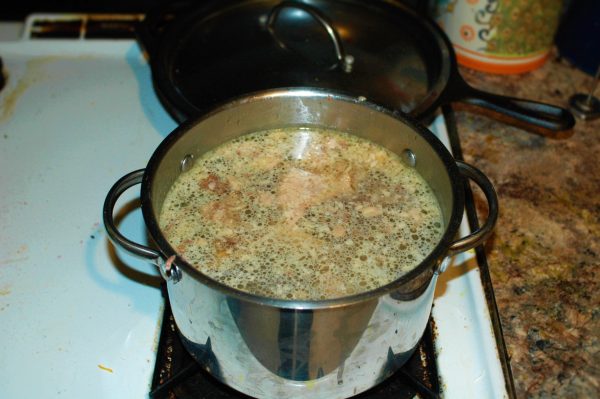
- Once you’ve assembled a collection of bones to fill about half the pot you intend to cook them in, put them in a pot and fill the rest of the pot with water. Add some vinegar (about a tablespoon per quart of water).
- At this point, some people add stuff like onions, carrots, and herbs to the pot. Logically, since there is nutritional benefit in vegetable stock, by doing this you are making both vegetable and meat stock at once and hence increasing the nutritional content. Personally, I don’t bother, because I like to add my vegetables directly to the meals I make with my stock and eat them whole. But, either way is fine. To veggie or not to veggie up your bone broth is entirely up to you.
- Boil.
- To extract high quantities of goodness from bones, you will need to boil them for 8–24 hours.
- You can use a stock pot, pressure cooker, slow cooker, or solar cooker. You can even make it in the oven. Pressure cookers break down bones faster and use less energy to produce the same results than other non-solar options. Solar cooking requires at least two good sunny days and a solar cooker large enough to accommodate a worthwhile amount of broth (or the patience to make small quantities of stock frequently).
- If you are not using a pressure cooker, you will likely have to add water to keep the bones covered at some point during this long cooking period. I normally turn my burner off while I sleep and fire it up again in the morning. This cuts down on fire hazards and ensures I don’t run out of water while I am not paying attention to the pot.
- Once you are done boiling, take the lid off for a little bit and let some of the liquid cook off. Your liquid line should be about halfway up your pot, or the same height the bones were when you first started cooking them.
- Then, use a sieve and strain out the bones. You can also run your liquid through a cloth napkin or flour sack if you want to remove all bits and traces of meat.
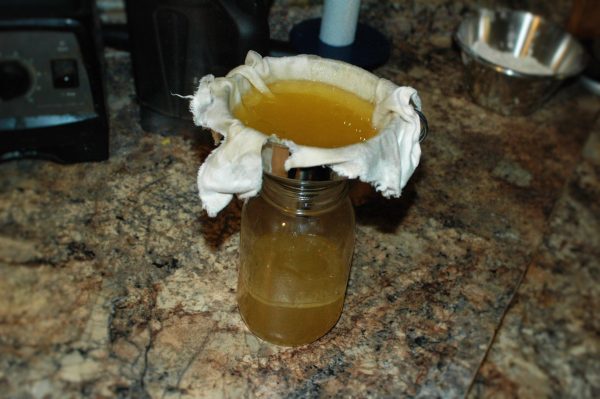
That’s it. Voilá! You now have bone broth so thick you can stand a fork in it. You can store this in the fridge for about five days or in the freezer for months.
Fine-Tuning the Quality of Your Homemade Bone Broth
So, why the big range on cooking times from 8–24 hours?
Well, because results vary by the kind and size of bones you use as well as by your cooking method.
- Research does show that longer cooking will extract more protein from the bones.5)https://www.alive.com/health/bone-broth-analysis-reader-research/ Eight hours is considered the minimum for good extraction.
- But I know from my own experimentation that movement during cooking helps break down bones faster, so a roiling boil is more effective than a soft simmer. And unless you are using a pressure cooker, stirring often also expedites bone breakdown.
- Duck and rabbit bones seem to cook down faster than chicken bones, and all poultry bones cook down faster than, say, large pork or beef bones.
Basically, cook as long as you can and use a pressure cooker for best results. Even if you can’t stick it out the full 24 hours, anything in between 8 and 24 hours will give you a good result.
There is not a lot of data about which bones from which type of animal specifically make the best stock. Chicken stock has proven to be useful in cutting mucus during a cold, but other bones might be just as useful for all we know. Really, I say use whatever bones you’ve got. I even mix bones from different animals to round out my stock pot.
You May Also Enjoy:
“How to Make (Almost) Instant Fire Cider”
One thing we can reason for ourselves, though, is that similar to the way that humans who are more physically active and eat a diverse natural diet tend to have better bone density than humans who are sedentary and eat a highly processed diet, bones from animals raised in confinement without access to fresh forage will not be the most nutritious for bone stock. Opt for animals that were well-raised, if possible.
Addressing the 1.4 Billion Ton Elephant in the Room
The health benefits of bone broth are a big reason why I include it in my diet. However, as a person who raises and processes my own animals, I also feel very strongly that we should use every part of the animal possible and limit our routine meat consumption to what our bodies really need.
Industrial meat production and excessive meat consumption have enormous environmental consequences for all of us. Our current ways of buying meat—all these boneless packaged cuts—is embarrassingly and shamefully wasteful.
On average, as much as 60 percent of the parts of our processed animals goes to waste. This means that, in the United States alone, we fail to use 1.4 billion tons of potentially viable animal parts—a majority of which is bones and organs.6)https://www.theatlantic.com/health/archive/2010/08/the-deadstock-dilemma-our-toxic-meat-waste/61191/
By transitioning to using bone-in cuts for larger animals and using whole poultry in our meal planning, we can then use those bones to stretch our budgets and cut down on the overall number of animal lives we need to take each year.
Sally Fallon, author of the “Nourishing Traditions” cookbook, makes a convincing case for bone broth as a “protein sparer” and a “must for those who cannot afford large amounts of meats in their diets.”7)Fallon, Sally, et al. Nourishing traditions: the cookbook that challenges politically correct nutrition and the diet dictocrats. NewTrends Publishing, Inc., 2005. I think bone stock and whole-livestock cooking habits should be considered a must for any meat eater who wants improved health and a saner, safer planet.
A Second Life for Cooked Bones
After you have boiled the heck out of your bones and they are spongy and mushy, you can also feed them to your pets or trench compost them in your garden. Bone broth bones decompose much faster than unboiled bones.
If you have a good meat grinder, you can also grind up those bones into ready-to-use bone meal for your garden.
The Many Uses of Bone Broth
True bone broth acolytes drink the stuff all day long like water.
For me, though, I like to incorporate it into my regular cooking:
- I’ll put a few spoons in the pan when I sauté or roast vegetables.
- I add a 50/50 mix of broth and water to my lentils, split peas, kidney beans, etc.
- I use a 75/25 mix to make vegetable-based soups.
- I use a 25/75 mix to make rice, risotto, quinoa, and other grains.
- I substitute 50 percent broth for whatever liquid is called for in savory batters. For example, using bone stock makes cornbread a rib-sticking lunch replacer for hungry homesteaders.
- I also like to add a bit to my quiche mix to make it both stiffer and fluffier.
- You can, of course, also use bone broth to make gravy, pot pie liquid, and the base for chicken (or duck, rabbit, deer) dumplings.
However you use it, I hope you use it often.
Bone stock won’t solve all our problems. But it is one of many things we can do to lighten our livestock load, enhance our health, and enjoy more homemade food.
What Do You Think?
Do you have any tips for how to make bone broth? What are your favorite ways to use it? Let us know in the comments below!
________________
________________
This article was originally published on December 11, 2017.
The Grow Network is a participant in the Amazon Services LLC Associates Program, an affiliate program designed to provide a means for our team to earn fees for recommending our favorite products! We may earn a small commission, at no additional cost to you, should you purchase an item after clicking one of our links. Thanks for supporting TGN!

Tasha Greer is a regular contributor to The Grow Network and has cowritten several e-books with Marjory Wildcraft. The author of “Grow Your Own Spices” (December 2020), she also blogs for MorningChores.com and Mother Earth News. For more tips on homesteading and herb and spice gardening, follow Tasha at Simplestead.com.
References
| ↑1 | https://www.ncbi.nlm.nih.gov/pmc/articles/PMC5533136/ |
|---|---|
| ↑2, ↑5 | https://www.alive.com/health/bone-broth-analysis-reader-research/ |
| ↑3 | http://time.com/4159156/bone-broth-health-benefits/ |
| ↑4 | https://www.healthline.com/nutrition/gelatin-benefits#section4 |
| ↑6 | https://www.theatlantic.com/health/archive/2010/08/the-deadstock-dilemma-our-toxic-meat-waste/61191/ |
| ↑7 | Fallon, Sally, et al. Nourishing traditions: the cookbook that challenges politically correct nutrition and the diet dictocrats. NewTrends Publishing, Inc., 2005. |
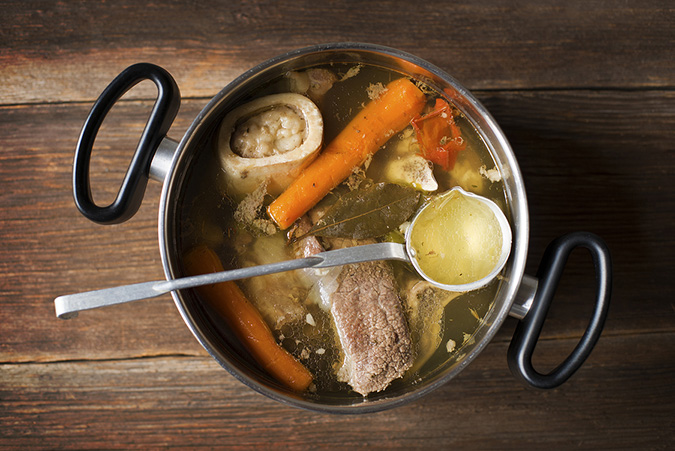
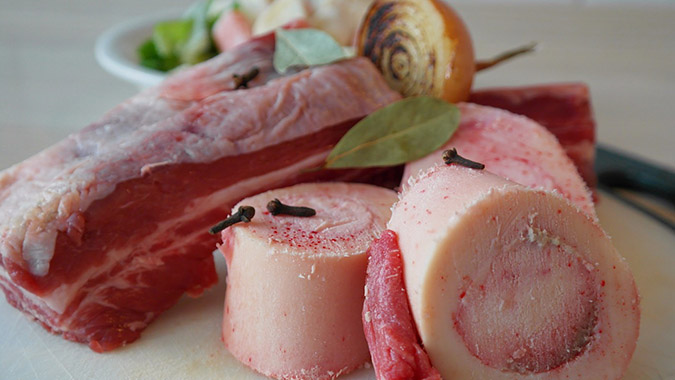

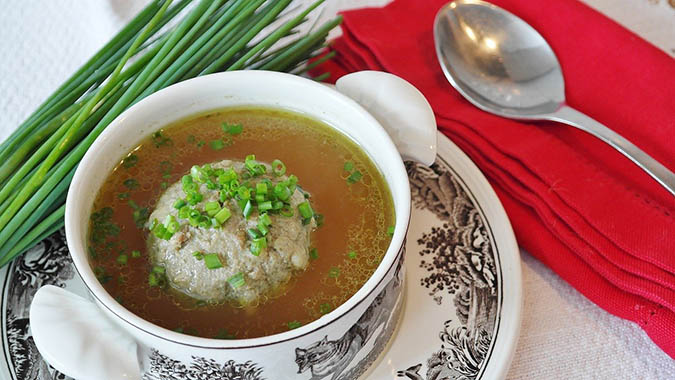







COMMENTS(15)
Hi..how long would one need to pressure cook the bone broth? Thank you
Hey Amita – I leave mine in for a full eight hours even in a pressure cooker. I like really, really thick broth! But one of our readers below said she does it for an hour or two and gets a good result. You may have to experiment and see what works best for you. Either way, I am sure it will be delicious!
When God made Woman he took a bone-rib from him and made woman,Now that’s some great bone broth!
Apparently, when lead enters the body it settles in the Bones. Reports show that Chicken Bone broth has 3-4 times as much lead than chicken meat broth
Thank you for pointing this out. I am aware of one study that showed lead was leached from chicken bones into broth. However, the Weston A. Price Foundation did a follow-up on this study. They wrote a very comprehensive post about it here: https://www.westonaprice.org/health-topics/bone-broth-and-lead-contamination-a-very-flawed-study-in-medical-hypotheses/. There were other, more comprehensive studies that showed there was no lead in chickens that were pasture-raised. I think the way the animal was raised makes a big difference. I raise my own chickens on pasture, or I buy from direct from farmers who do. So, I feel comfortable making bone broth with my bones. But I am not so sure I would if I were buying from the grocery store. Thank you again for raising this issue. It’s important that we all make informed decisions about what we eat.
Try canning it. Having rows of jarred broth in the pantry is a real timesaver. We butcher our own animals, so I spend several days cooking down all the bones and bits into broth and then can it up for my pantry.
I do this too! I also make extra for my chickens, ducks, pigs, and dog. I give it to them as a warm treat on cold days. They love it!
I love….. bone broth and make mine with my pressure cooker. Just an hour or two does the trick. Try some of it cold with just a sprinkle of salt for a refreshing treat. It’s great that you mentioned feeding the soft bones to your pets which I do, but actually, I leave a few bones in there and when it’s cold I just eat them too. Admittedly, I have been cautious about that,… wondering if that’s safe for me to eat. I’m thinking it wouldn’t be too good of an idea unless the bones are organic and such.
Thanks for your tips.
I have made bone broth for years. It’s better to skim off the foamy scum…broth will taste better without those impurities. Also venison meat is great, but the bones make a very gamey smelling and gamey tasting broth. Turkey bone broth is my hands down favorite. For best flavor, always make bone broth with an onionat least.
Question ? Just wondering I buy pasture raised egg from the health food store,
has anyone saved egg shells and boiled them with the bones ?
And yes to sell in a store they have been cleaned. Thank You
I have never tried boiling the eggs shells with bone broth. I have washed, dried, and ground the egg shells to make a calcium supplement for me and my chickens. I am sure there would be some calcium extraction from the long-boiling with the bones. However, I suspect the calcium content would be higher in the powder form than when used in stock. If you do try this, drop us a line and let us know how it goes. I am interested to hear how your experience goes. Thanks! Tasha
I make mine in a crock pot for 24 hours.Love it.I add garlic to mine
Thank you for this post! I have been on a list with my local meat processing plant that they use to call when meat doesn’t get picked up. Their space is very limited and deer have been plentiful this year so it works well for someone who cannot hunt anymore. So your article reminded me that they also give away bones that are full of meat because everyone wants their meat processed as boneless. I literally stopped in the middle of your article to take them a tub to fill with delicious, free food! Thanks again!
I always cook mine for at least 24 hr. Cut up a whole fryer, put it in a large pot with a large onion cut in quarters with peeling on, carrots celery, bay leaf, salt pepper and any other leftover vegis. Cook the chicken for 45 min. Pull it out, cool enough to handle remove all meat. Put everything else back in pot, skin n all. Cook for remaining 23 hours. When finished I pour through a chinois a couple times, Then I have good chicken meat for whatever and I get 4 quarts of beautiful golden stock for curry’s and other soups. Always have some in the freezer.
i love bone broth! i mainly cook it for our animals because of how good it is for them. I am glad to hear im not the only one who gives the mushy bones to the dogs. I do mush them down though